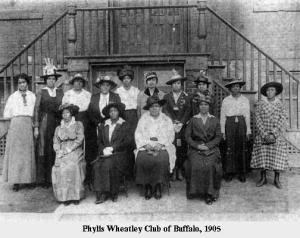Women’s Rights LAB: Black Women’s Clubs

The goal is to help students learn more about Black Women’s Clubs, Mary Church Terrell, and the Women’s Suffrage Movement. Class time should focus on introducing the topic and document analysis. As a warm up activity, students will examine a photo of a Black Women’s Club and make 3 observations. This can be done as a class or individually. Students will then read and annotate a reference article on Black Women’s Clubs. Next, students will analyze 2-3 primary sources by completing the LAB graphic organizer. As an assessment, students practice making a claim based on evidence from the sources in their response.
45 Minutes
By the end of this lesson, students will be able to make an evidence-based claim about Black Women’s Clubs and their role in the Women’s Suffrage Movement. To do this, students will organize information based on evidence from primary and secondary sources relevant to the topic.
Guiding Question
How did Black Women’s Clubs and their leaders play a role in the Women’s Suffrage Movement?
Supporting Questions:
-
What were Black Women’s Clubs?
-
Why were Black Women’s Clubs formed?
-
Who was Mary Church Terrell and how did she lead?
-
Why is March Church Terrell historically significant?
- Students should already know the steps for annotating primary sources.
- Students should have some background knowledge on the women’s suffrage movement.
- If this is the first LAB students are doing, expect to use more time to explain the process.
- Photograph for Warm Up: Click on the photo of the Women’s Club in Buffalo to enlarge it.
Options for Reference Article and/or Video Introduction:
- NWHM: National Association of Colored Women or African American Reformers: The Club Movement
- Women’s Museum of California: “Lifting As We Climb”
- The Women’s Club Movement Video Intro
LAB Sources:
- Poster and speech from the first meeting of the First National Conference of Colored Women (Women & The American Story (New-York Historical Society)
- Mary Church Terrell: Black Suffragist and Civil Rights Activist (National Park Service): The excerpt to use for this source is included as a Word Document.
- LAB Graphic Organizer
Warm Up:
-
Post the photo of the Buffalo Women’s Club at the front of the classroom for students to see as they walk in.
-
Ask students to make 3 observations of the photo.
-
They can write these down and then discuss either through a turn and share or you can call on 3 different students to share their ideas.
-
Ask students which group they think it is and/or why these women are posed together for a photo if no one raises these points in their observations.
Activity 1:
-
Hand out the reference article and give students time to read and annotate it (choose from the options provided for the article you think best suits your class).
-
Students should annotate the article as they read; underline/highlight key details and make margin notes.
Activity 2:
-
Hand out the LAB Graphic Organizer Set and 2-3 of the source options provided.
-
On the first page of the LAB, students organize the source information. Depending on time and your own classroom goals, use the poster and the excerpts from Mary Church Terrell if you are only using 2 sources. If you want to use 3 sources, include the speech.
-
Let students examine and analyze the sources.
-
On page 1 of the LAB, students label the sources and fill in 3 facts from each of them. They also have a space to list limitations of the sources.
-
On page 2, students organize their evidence for the 3 LAB categories: leadership, action, and bravery*.
Activity 3:
-
The lesson assessment is an opportunity for students to practice making a claim based on evidence.
-
Using page 3 of the LAB, students have room to answer the guiding question.
-
This is where they write their claim and they must use evidence from the sources in their response. This can be started at the end of class or given as the Assessment/Homework.
Closing Activity:
-
Have a short class discussion that highlights three new facts students learned from today’s lesson.
*Guiding questions for page 2 of the LAB:
- Leadership: Does the source show examples of leadership? How?
- Action: Which actions are taken according to the source? Who is acting?
- Bravery: Do you see examples of bravery? Who is being brave? How are they being brave?
As a modification, teachers can use Activity 3 as Assessment/Homework.
Lesson Modifications:
-
The teacher can read the reference article out loud to the class (students should be annotating while that happens).
-
Instead of a reference article, the teacher may choose to use a video clip that introduces the topic.
-
The teacher can walk the class through each step of the LAB in specific time increments as opposed to allowing the students to work at their own pace.
-
Alternative methods of making a claim could be used, such as creating a poster or a cartoon/comic strip type of drawing.
Suggestions for extension projects:
-
Create an advertisement, banner, or social media post that calls attention to areas of citizenship that the United States could improve upon.
-
Write a letter to the editor/opinion piece on an area of citizenship that students think the United States could improve upon.
D2.His.2.6-8
D2.His.3.6-8
D2.His.12.6-8
D2.His.16.6-8
D4.1.6-8
D4.2.6-8
